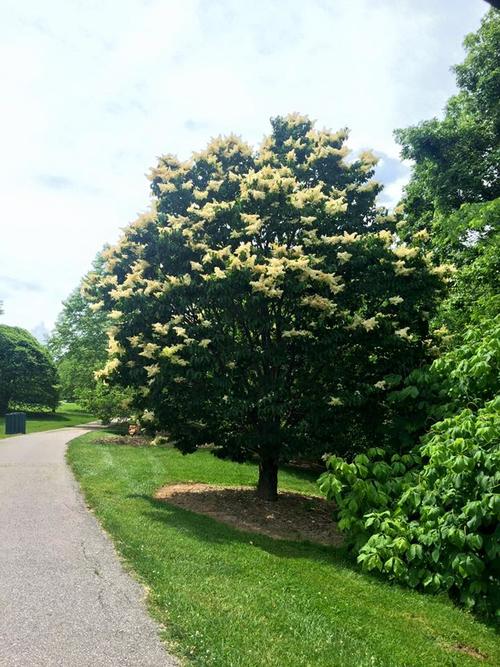Syringa reticulata
Japanese Tree Lilac
Mature Size, Growth, Longevity
Average mature size of 20-30' tall and 15-25' wide. Upright habit. May have multiple trunks. Oval to round-topped. Large shrub to small tree. Medium growth rate, 9-12' over 6-8 years.
Native Range
Native to northern Japan introduced 1878.
Flower and Fruit Details
Flowers are creamy, fragrant, borne in large, terminal panicles, 6-12" long and 6-10" wide. Blooms from late May into June, much later than the common shrub lilacs. The white flowers have yellow anthers, which creates the overall, creamy-white appearance. Fruits are dehiscent capsules, warty, glabrous, scimitar-shaped, 0.75" long, blunt at apex, August to October.
Leaf and Bark Features
Deciduous: Leaves are opposite, simple, entire, ovate, 2-5.5" long and half as wide, acuminate at the tip, dark green on top, gray-green and reticulate beneath and glabrous to slightly pubescent, with a 0.5-1" petiole. No significant fall color. Notable Bark: Bark is glossy, cherry-like, reddish-brown to brownish, with prominent horizontal lenticels. Often confused with a cherry during the winter, until one notes the opposite buds on the lilac twigs. Bark on young twigs even peels like cherry bark.
Culture and Care
Easy to transplant into loose, well-drained, slightly acid soil, in full sun for best flowering. Faded flowers may be pruned off with a pole pruner. Lilacs are actually quite pH adaptable, tolerating alkaline soils very well. Zones 3-7. Seldom has many insect or disease problems, but is susceptible to bacterial blight, phytopthora blight, leaf blights and spots, wilt and other pathological problems. Resistant to powdery mildew, scale and lilac borers.
Strengths, Weaknesses, Other Facts
Has been referred to as "the finest of the tree lilacs." Author and plantsman, Dr. Michael Dirr, calls it "possibly the most trouble-free lilac," and he considers it "the toughest of the lilacs." Some find the privet-like fragrance of the flowers unappealing. Also known as 'Morton'.
Suggested Uses
Makes an excellent street tree or specimen tree. Good in group plantings or in front of large buildings.
Taxa and Plants of this Species at BCA
The following taxa are (or were) represented in the collections at Boone County Arboretum. Additional taxa may be available in the trade that are not included here.
Syringa reticulata // Japanese Tree Lilac ("straight species")
Tree.
BT001540Syringa reticulata 'Ivory Silk' // Ivory Silk Japanese Tree Lilac
Tree. Selection introduced in 1973 by Sheridan Nurseries, Ontario, Canada. Still one of the best. Likes cool summers. More sturdy, compact, dense and globose to oval-rounded than most tree lilac cultivars. Blooms heavily at an early age. Ivory-white flowers. Drought-tolerant and free of insects and diseases. Received the Pennsylvania Horticultural Society's Gold Medal in 1996, and is the University of Kentucky Nursery & Landscape Program's 2000 Theodore Klein Plant Award Winner. Gets 20-25' tall and 12-15' wide.
BT001802 - BT002170 - BT002180 - BT002210Syringa reticulata subsp. pekinensis 'China Snow' // China Snow Peking Lilac
Tree. Yellowish-white flowers in 3-12" long panicles. Gets 15-20' tall and wide. Fine textured. Often multi-stemmed. Upright-arching, loose and open habit. Subspecies native to northern China, introduced 1881. Has a more informal habit than S. reticulata. Showy, papery, exfoliating, rich brown to golden-brown or amber-cherry-red, thin sheets of bark on 'China Snow' resembles that of Prunus serrula. Zones 4-7. Blooms late May into June. More heat-tolerant than straight species S. reticulata. Leafs out early in the spring, with dark green summer foliage that may turn yellowish in fall.
BT001231 - BT008472 - BT008473 - BT008474

